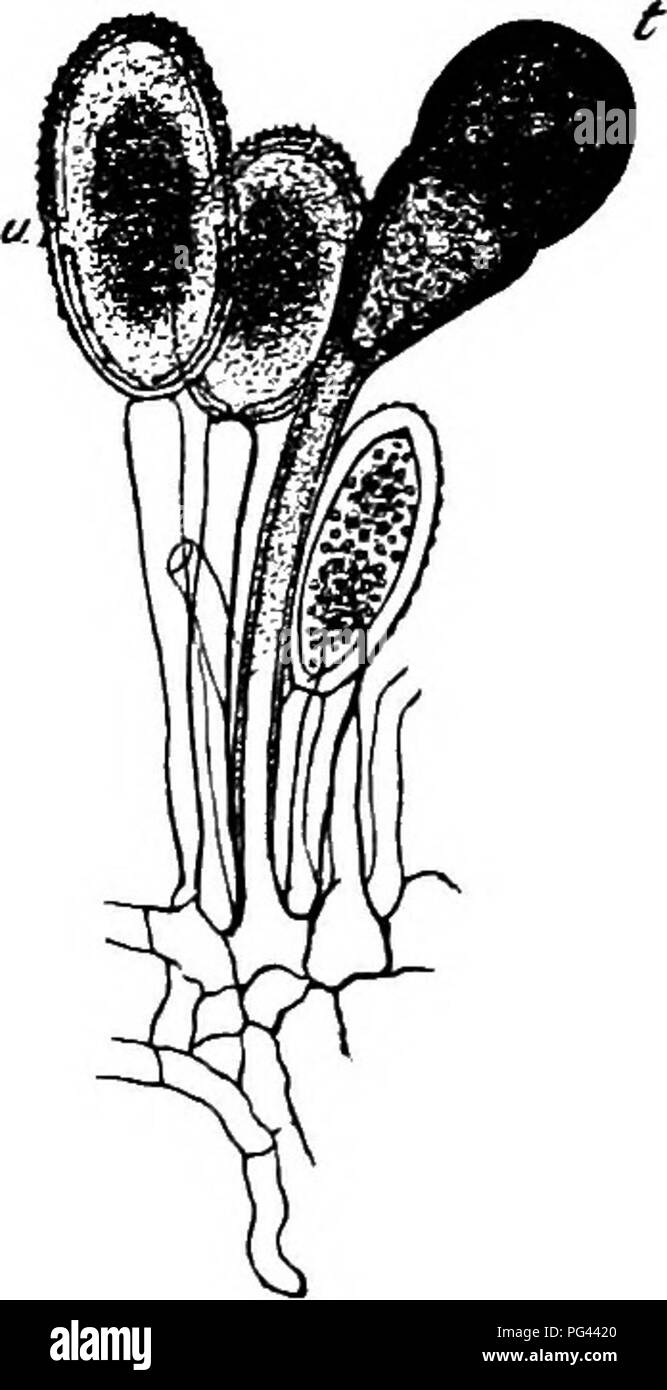. Comparative morphology and biology of the fungi, mycetozoa and bacteria . Plant morphology; Fungi; Myxomycetes; Bacteriology. CHAPTER III.—SPORES OF FUNGI. lOI Others perform no such function and are therefore only simple pores or pits. The position of the pores on the membrane is different in different species. The spores, for instance, of Sordaria fimiseda, de Not. have at their apex a germ-pore which is closed only by the outermost lamella of the membrane (Fig. 52). The germ-pores of the uredospores which I have examined, those of Puccinia for example and Uromyces, are sharply defined rou

Image details
Contributor:
Central Historic Books / Alamy Stock PhotoImage ID:
PG4420File size:
7.1 MB (215.4 KB Compressed download)Releases:
Model - no | Property - noDo I need a release?Dimensions:
1132 x 2206 px | 19.2 x 37.4 cm | 7.5 x 14.7 inches | 150dpiMore information:
This image is a public domain image, which means either that copyright has expired in the image or the copyright holder has waived their copyright. Alamy charges you a fee for access to the high resolution copy of the image.
This image could have imperfections as it’s either historical or reportage.
. Comparative morphology and biology of the fungi, mycetozoa and bacteria . Plant morphology; Fungi; Myxomycetes; Bacteriology. CHAPTER III.—SPORES OF FUNGI. lOI Others perform no such function and are therefore only simple pores or pits. The position of the pores on the membrane is different in different species. The spores, for instance, of Sordaria fimiseda, de Not. have at their apex a germ-pore which is closed only by the outermost lamella of the membrane (Fig. 52). The germ-pores of the uredospores which I have examined, those of Puccinia for example and Uromyces, are sharply defined round holes in the endosporium, and are closed by the episporium on the outside; those of the teleutospores of the same genera appear to be pits in the episporium, which do not however extend into its outermost lamellae and seem to be closed on the inner side by the unpierced endosporium. Some, perhaps many, uredospores (those of Puccinia graminis for instance) show a pit at their point of attachment which is of no service for germination (Fig. 51). The spores of some Basidiomycetes, as Hymenogaster Klotzschii, are furnished with a pit at the same. Fig. 50. Ckrysomyxa Rhododendri. Basidium from an aecidium bearing a chain of spores. For the explanation see the accompanying text and on page 71. Magn. 600 times. Fig. 51. Puccinia graminis. Small portion of a hymenium; it uredospores with four germ- pores in their aequator, t a pair of teleuto- spores, the upper one with a germ-pore in its apex. Magn. 390 times. place which seems to belong to the episporium. The majority of the spores of the Basidiomycetes have no pit at this spot, but are prolonged into a small stalk which Corda ^ mistook for a pit. This stalk, as far as I could ascertain in the large-spored Corticium amorphum (see Fig. 30), is mainly a continuation or protuberance of the endosporium, over which the episporium is not continued or is present only as a very thin membrane ; the stalk itself shows a narrow lumen, or i